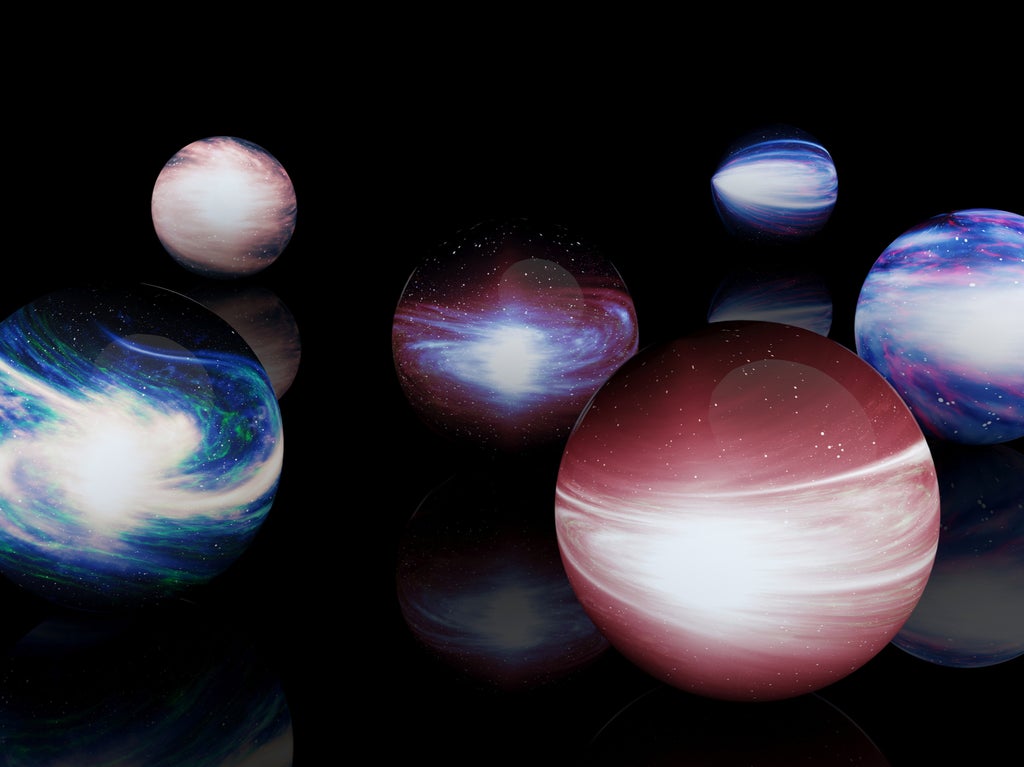
In 2009, two Stanford physicists, Andrei Linde and Vitaly Vanchurin, wrote a paper calculating the number of possible universes that could exist, based on the prevailing theory, then and today, of how our own cosmos originated 14 billion years ago.
Their answer was 10^10^10,000,000 – that is one followed by a billion zeros.
I didn’t write about it at the time because it was hardly news. Even bigger numbers of potential universes were being tossed around, based on other speculations about physics and cosmology.
A short century ago, astronomers could barely comprehend the notion of one universe. Now, that idea is not big enough to fill the dreams of theorists. There are as many possible universes as a mind can concoct, spun out of imagination, despair, hope, heroic mathematical extrapolation and that ol’ what-if spirit to answer questions that most of us didn’t know we had. Welcome to the “multiverse.”
There is not a scintilla of evidence that other universes exist, nor any idea of how to detect them, much less how we might go about visiting the one next door. But none of that has kept the idea from becoming a trope of science fiction, modern cosmology and popular culture – movies, in particular. Hardly a new Marvel film comes out without its heroes bopping in and out of strange space-times on some quest or another.
So meet Evelyn Wang, a middle-aged Chinese immigrant who runs a laundromat and has issues with her taxes, her traditionally forbidding father (newly arrived from China) and her lesbian daughter. In the new film Everything, Everywhere All at Once, Evelyn has been picked to save the realm of universes from a destructive demon because she is such a loser in this one. Above all, she must reconnect with her daughter, the main agent of chaos in her local cosmos. Thus, she finds herself careening through alternate universes and alternate versions of the self she might have been.
The movie was written and directed by Daniel Kwan and Daniel Scheinert, who call themselves the Daniels and are best known for the 2016 film Swiss Army Man, about a flatulent corpse played by Daniel Radcliffe.
Their new film is a meditation on the loneliness of the infinite disguised as a raunchy kung-fu astro-comedy, featuring sly references to other movies like Ratatouille and 2001: A Space Odyssey. In one universe, Evelyn has rubbery hot dogs for fingers. In another, she is a famous martial artist and movie star. At the far end of her journey, signifying the ultimate doom and psychic black hole, is a giant, ominous everything bagel.
The multiverse, with its billions upon billions of alternate realities telescoping outward, would seem to only amplify our insignificance
The movie, which premiered at South by Southwest in March, has generated enthusiastic reviews. As a self-appointed aficionado of all things cosmic, I was eager to see it and to learn the nuts and bolts of their multiverse.
Speaking over Zoom, the Daniels proclaim themselves devoted fans of pop science and cosmology. They sent me a copy of A Vast Pointless Gyration of Radioactive Rocks and Gas in Which You Happen to Occur (A24 LLC), a collection of science and speculative writing by authors including Jorge Luis Borges and Carl Sagan, which they edited.
Needless to say, there is not just one theory of the multiverse but many, depending on the physics you adopt. For instance, the “many worlds” interpretation of quantum mechanics posits that whenever you make a decision – say, to turn left out of your driveway instead of right – the universe splits in two and continues branching at every intersection. There is a universe for every way you could turn, every way a ball could come off Aaron Judge’s bat, every way a cookie could crumble.
Another version of the multiverse arises from string theory, the purported “theory of everything” that describes elementary particles as vibrating strings of energy. “Theory of Anything” might be a better moniker; it turns out that the theory has at least 10^500 solutions in 11 different dimensions, each of which represents an alternate universe, perhaps with its own laws.

Still another multiverse springs from the prevailing, though not fully confirmed, theory of cosmic inflation. Thanks to a violent whoosh fueled by negative gravity at the dawn of time, an endless array of bubble or “pocket” universes are branching off from one another at a dizzying, exponentially increasing rate.
The Daniels describe their multiverse as a combination of Many Worlds and the cosmic bubble bath implied by inflation theory. “It’s fun to imagine both versions,” Kwan said. “Both of them are pointing toward infinity or just pointing toward the unknown.”
But, they added, their film is less about physics than about how physics makes you feel. “If you could see alternate lives, that would be – that would send you spiralling,” Scheinert says. “It would send any of us kind of spiralling about, like, lives you could have led and choices you could have made.”
The multiverse, they say, could also be a metaphor for the attention-deficient lives we have embraced in our bubbles of social-media truth. “I think our stories have to constantly be looking for ways to calm us down again or to bring us back to another version of being centres and grounded again,” Kwan says.
Evelyn’s back story, Kwan says, is that she suffers from ADHD (as does Kwan), and so she flits distractedly from one activity to another, never mastering any of them. She is a Marco Polo of the multiverse, with more “what ifs” to explore across the dimensions of reality than anyone else.

Whatever you might think of the multiverse, it is a logical next step in our progression from the Earth-centered universe of Ptolemy to the modern cosmos of dark energy, fantastic galaxies and, perhaps, other life-forms.
“Every new discovery is decentering the human experience, which can be really terrifying,” Kwan says.
Who knows what else we will soon move beyond. Beauty is “nothing but the beginning of terror,” the poet Rainer Maria Rilke wrote. “It amazes us so, because it serenely disdains to destroy us.” The night sky is filled with stars incomprehensibly distant, and it is incomprehensibly powerful. What or who is out there? Will anyone ever know about us? The more we learn about the cosmos, the smaller we feel.
The multiverse, with its billions upon billions of alternate realities telescoping outward, would seem to only amplify our insignificance. “The more the universe seems comprehensible, the more it seems pointless,” physicist Steven Weinberg, who died last year, once said. Evelyn, at the end of her quest, concludes: “Nothing matters.”
But that realisation can also be inspiring, the Daniels contend. “I think it’s probably one of the most freeing ideas we can have,” Kwan says.
“I grew up in a very religious home, and so everything mattered,” Kwan says. “And when everything matters, it’s a horrifying experience navigating the world, because everything, every action, is filled with regret, and every action is filled with guilt in a way that can be crippling.”
Whereas if nothing matters, you are not responsible for the universe. Nothing is ordained, anything goes; do what you want, love whom you want. And those hot dog fingers go great with mustard and ketchup.
This article originally appeared in The New York Times







